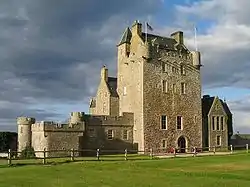Ackergill Tower
Ackergill Tower (or Ackergill Castle) is located on the coast of Sinclair's Bay, about 4 km north of Wick, Caithness, in northern Scotland. It was built in the early 16th century, and is a category A listed building.[1] The building is a five-storey oblong tower house. The four-storey wing to the rear was added in the early 18th century.[1]
| Ackergill Tower | |
|---|---|
| Wick, Caithness, Scotland GB grid reference ND352546 | |
 Ackergill Tower | |
 Ackergill Tower | |
| Coordinates | 58.47480°N 3.11273°W |
| Type | Tower house with some extensions |
| Site information | |
| Owner | Private, Dr Betsee Parker |
| Condition | Intact |
| Site history | |
| Built | Late 15th or early 16th century[1] |
| Built by | Clan Keith |
| In use | 15th century to present |
| Materials | Stone |
From 2014, Ackergill Tower was operated as an events and wedding venue by AmaZing Venues,[2] before being sold to US philanthropist, Dr Betsee Parker in February 2019.
History
Early history
The Clan Keith, under John Keith of Inverugie, inherited the lands of Ackergill in 1354 from the Cheynes family.[1] Ackergill Tower may have been built by his son, but was first mentioned in 1538.[1]
A legend relates the tale of a young woman by the name of Helen Gunn, who was abducted by John Keith for her beauty. She flung herself, or fell, from the highest tower to escape her abductor's advances. Supposedly her ghost is still seen.[3] This was in the late 14th or early 15th century and is said to have been the true beginning for all feuding between the Gunns and the Keiths. It led to the Battle of Champions in either 1478 or 1464, a judicial combat which led to a massacre of the Gunns by the Keiths at the chapel of St Tear (or Tayre) just east of the village.
Keiths and Sinclairs
In 1547, the Sinclairs of Girnigoe attacked and seized the castle. Mary of Guise, then Regent of Scotland, granted the Sinclairs remission for this and returned Ackergill Tower to the Keiths. She later installed Laurence Oliphant, 4th Lord Oliphant, as keeper of Ackergill in 1549. The Sinclairs again captured the castle in 1556, for which they were again granted remission. John Keith, Captain of Ackergill, was present at the death of Mary of Guise at Edinburgh in 1560.[4]
In 1593, Robert Keith, brother to George Keith, 5th Earl Marischal (who rightfully owned the tower), seized Ackergill by force, for which he was declared a rebel, and the castle was returned to the Earl.[5] In September 1597 John Keith of Subster attacked the tower in the dead of night, climbing the walls with ladders, taking its occupants by surprise and capturing the place.[6]
In 1612, the Sinclairs acquired Ackergill Tower once again, but through legal means, when it was sold to the Earl of Caithness by the Earl Marischal. However, by 1623 it was under assault once more, when it was besieged by Sir Robert Gordon during his feud with George Sinclair, 5th Earl of Caithness. The Sinclairs surrendered the castle before any assault took place.
In 1651, Oliver Cromwell may have used Ackergill Tower to garrison his troops during his siege of the Keith's Dunnottar Castle, when he was hunting for the Honours of Scotland. In 1676, John Campbell, 2nd Earl of Breadalbane and Holland took possession of Ackergill Tower in repayment of debts owed to him by the Sinclairs.
Later history
John Campbell put Ackergill Tower up for sale in 1699, and it was bought by Sir William Dunbar of Hempriggs. The Dunbars began extensive renovations, including the addition of a lean-to-shaped extension to the tower. In the mid-19th century, further additions including a cap house were made by the architect David Bryce on behalf of George Sutherland Dunbar, 7th Lord Duffus.[1] In 1963, Maureen Blake, who as a girl lived with her mother and C. S. Lewis for about twenty years, became the eighth baronetess of Hempriggs and the steward of Ackergill Tower until it was sold in 1986. The castle underwent a two-year period of restoration work before opening as an exclusive hotel and business venue.
The tower was sold again in 2009, and the new owners, AmaZing Venues, part of Clarenco LLP, acquired a five-star rating in 2012 having spent £2 million upgrading facilities.[7]
The tower was sold once more in 2018, and returned to private ownership.
References
- Historic Environment Scotland. "ACKERGILL TOWER, GARDEN WALLS, WALLED GARDENS AND STABLE RANGE (Category A Listed Building) (LB14072)". Retrieved 30 December 2018.
- "Ackergill Tower". AmaZing Venues. Archived from the original on 16 December 2014. Retrieved 14 May 2014.
- "Ten of Scotland's most haunted hotels". Scotsman.com. 29 July 2010. Retrieved 7 September 2012.
- HMC 3rd Report: Murray (London, 1872), p. 412.
- Miles Kerr-Peterson, A Protestant Lord in James VI's Scotland: George Keith, Fifth Earl Marischal (Boydell, 2019), pp. 65, 69.
- Register of the Privy Council of Scotland, vol. 5 (Edinburgh, 1882), p. 455.
- Clark, Will (7 November 2012). "Ackergill Tower joins five-star set". John O'Groat Journal. Archived from the original on 11 December 2012.
External links
- Ackergill Tower, Caithness.org